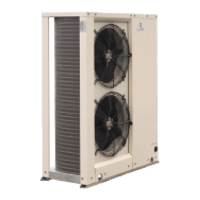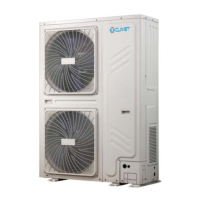Do you have a question about the CLIVET MSAT-XEE 8.2 and is the answer not in the manual?
| Model | MSAT-XEE 8.2 |
|---|---|
| Category | Heat Pump |
| Refrigerant | R410A |
| Operating Temperature Range (Cooling) | 46 °C |
| Operating Temperature Range (Heating) | 24 °C |
| Power Supply | 50Hz |
Identifies the unit as an air-cooled condensing unit for outdoor installation, model MSAT-XEE 8.2-30.2.
Details the manual's purpose and states that only qualified personnel can operate the unit.
Highlights potential risks and defines the unit's intended use for air-conditioning.
Details installation requirements, maintenance planning, and modification warnings.
Addresses breakdown procedures and the necessity of user training by the installer.
Explains unit identification via serial number and how to request assistance.
Details checks for unit reception, storage, and safe handling procedures.
Advises on careful removal of packaging and proper disposal.
Defines necessary spaces around the unit and lists criteria for selecting the optimal installation site.
Addresses installer responsibility for drain tubes related to safety valves.
Covers shut-off valves and warns about potential explosion risks from trapped refrigerant.
Details requirements for suction/liquid lines and recommends liquid receiver installation.
Provides steps for checking refrigerant leaks and performing vacuum operations.
Details refrigerant charging, oil considerations, and references accessories.
Explains electrical data sources and provides steps for safe electrical connections.
Covers routing signal cables and power input connections with safety notes.
Details customer wiring, remote controls, and serial communication modules.
Outlines general start-up requirements and essential preliminary checks.
Details the step-by-step sequence of operations for starting up the unit with power supplied.
Details checking compressor rotation, monitoring refrigerant circuit parameters, and electric circuit checks.
Explains the use and importance of compressor crankcase heaters for start-up.
Covers voltage checks, remote control verification, and the importance of start-up reports.
References the 97/23 CE PED directive for installation and verification requirements.
Explains the unit's display icons and the functions of the control panel keys.
Describes how to activate and deactivate the unit's standby mode.
Guides through navigating the control menu and changing operating modes.
Details how to turn the unit ON/OFF and change its operating mode.
Provides instructions for setting the clock and silencing active alarms.
Explains how to view the status of various digital and analogical inputs and outputs.
Covers accessing, resetting, and logging unit alarms.
Details alarm log reset procedures and introduces the configuration setting menu.
Explains how to set up different daily operating schedules with multiple events.
Provides detailed steps for configuring scheduling numbers, events, and daily assignments.
References remote control functionality and explains ambient temperature display settings.
Details settings for ambient temperature display and ambient keyboard control.
Covers general maintenance principles and recommends inspection frequencies.
Advises on creating a unit booklet and provides guidelines for standby mode and long inactivity.
Details checks for compressor shut-off valve, control systems, and air coil cleaning.
Outlines checks required for electric fans, their fixing, bearings, and terminal covers.
Instructs on safe disconnection, refrigerant recovery, authorized disposal, and RAEE directive compliance.
Covers general risks, danger zones, handling, and installation hazards.
Details electrical, moving parts, refrigerant, and hydraulic risks with safety precautions.
Presents dimensional drawings and specifications for unit sizes 8.2, 10.2, and 12.2.
Presents dimensional drawings and specifications for unit sizes 16.2, 18.2, and 22.2.
Presents dimensional drawings and specifications for unit sizes 26.2 and 30.2.
Provides comprehensive technical data, including capacity, power, dimensions, and weights for all unit sizes.
Details sound pressure and power levels across octave bands for various unit sizes.
Illustrates the unit's operating range based on saturated suction temperature and outdoor conditions.
Lists accessories categorized by function and provides examples like remote controls and antivibration mounts.
Provides detailed information and wiring for the RCTX remote control accessory.
Details the installation and cable characteristics of the CMSC2X serial communication module.
Explains HGBP functionality and provides a scheme for the KCX Connection Set.
Lists alarm codes, their descriptions, types, and details input/output status codes.
Continues listing status codes for digital inputs, outputs, and compressor operating hours.











